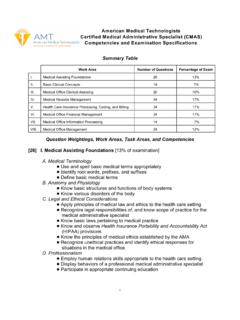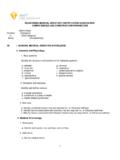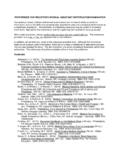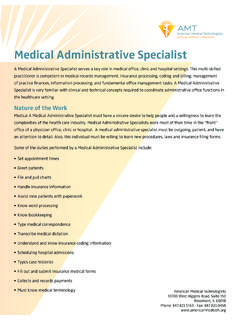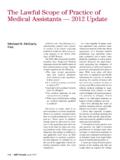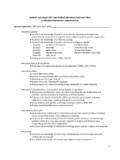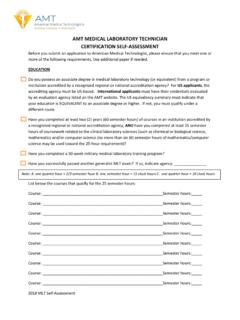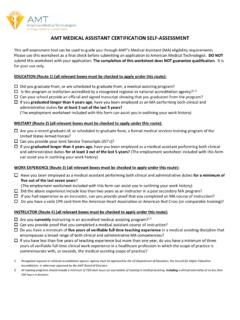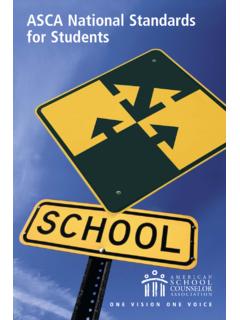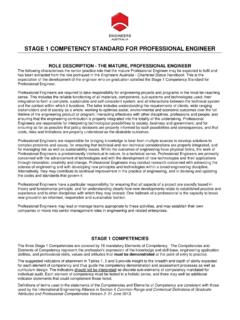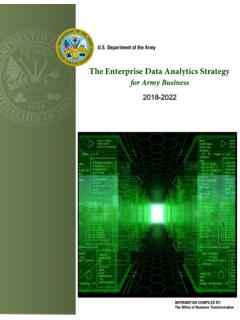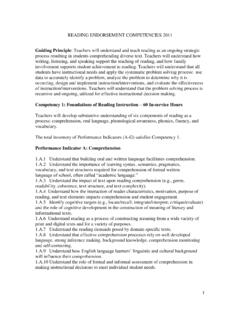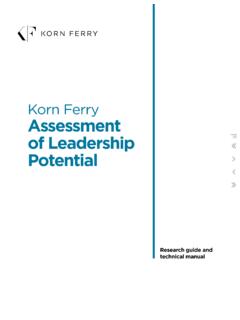Transcription of Registered Medical Assistant (RMA) Certification Examination ...
1 2020 American Medical Technologists. All rights reserved. Page 1 of 15 Registered Medical Assistant (RMA) Certification Examination competencies and Examination Specifications Summary Table Work Area Number of Questions Percentage of Exam I. Anatomy and Physiology 46 II. Administrative Medical Assisting 75 III. Clinical Medical Assisting 31 IV. Clinical Patient Interaction 58 Total 210 Question Weightings, Work Areas, Task Areas, and competencies 46 I. ANATOMY AND PHYSIOLOGY ( of exam) A. Body Systems 1.
2 Identify the structure and function of the following systems: a. skeletal g. nervous b. muscular h. respiratory c. endocrine i. cardiovascular/circulatory d. urinary j. integumentary e. reproductive k. special senses f. gastrointestinal 2. Disorders and diseases Identify and define various: a. disease processes b. conditions or states of health c. health-related syndromes 3. Wellness and nutrition a. Identify nutritional factors that are required for, or influence wellness b. Identify factors associated with exercise that are required for, or influence wellness # c.
3 Identify factors associated with lifestyle choices that are required for, or influence wellness B. Medical Terminology 1. Word parts a. Identify word parts: root, prefixes, and suffixes 2020 American Medical Technologists. All rights reserved. Page 2 of 15 2. Definitions a. Define Medical terms 3. Common abbreviations and symbols a. Identify and understand utilization of Medical abbreviations and symbols 4. Spelling a. Spell Medical terms accurately 5. Terminology a. Define terminology associated with specialty examinations 75 II.
4 ADMINISTRATIVE Medical ASSISTING ( of exam) A. Insurance 1. Terminology a. Identify and define terminology associated with various insurance types in the Medical office 2. Plans a. Identify and understand the application of government, Medical , disability, and accident insurance plans b. Identify and appropriately apply plan policies and regulations for programs including: 1. HMO, PPO, EPO, indemnity, open, etc. 2. Short-term and long-term disability # 3. Family Medical Leave Act (FMLA) 4. Workers Compensation a.
5 Complete first reports b. Complete follow-up reports # 5. Medicare (including Advance Beneficiary Notice (ABN)) 6. Medicaid 3. Claims a. Complete and file insurance claims # 1. File claims for paper and Electronic Data Interchange # 2. Understand and adhere to HIPAA Security and Uniformity Regulations b. Evaluate claims response # 1. Understand and evaluate explanation of benefits # 2. Evaluate claims rejection and utilize proper follow-up procedures # 4. Coding a. Identify HIPAA-mandated coding systems and references 1.
6 ICD-10-CM 2. CPT 3. HCPCS 2020 American Medical Technologists. All rights reserved. Page 3 of 15 b. Properly apply diagnosis and procedure codes to insurance claims 5. Insurance finance applications a. Identify and comply with contractual requirements of insurance plans # b. Process insurance payments and contractual write-off amounts c. Track unpaid claims # d. Generate aging reports # B. Financial Bookkeeping 1. Terminology a. Understand terminology associated with Medical financial bookkeeping 2. Patient billing a.
7 Maintain and explain physician's fee schedules b. Collect and post payments # c. Manage patient ledgers and accounts # d. Understand and prepare Truth in Lending Statements e. Prepare and mail itemized statements # f. Understand and employ billing cycles 3. Collections a. Prepare aging reports and identify delinquent accounts b. Understand application of the Fair Debt Collection Practices Act c. Understand and perform appropriate collection procedures # 4. Fundamental Medical office accounting procedures a. Employ appropriate accounting procedures # 1.
8 Pegboard / double entry # 2. Computerized # b. Perform daily balancing procedures # c. Prepare monthly trial balance # d. Apply accounts receivable and payable principles 5. Banking procedures a. Understand and manage petty cash account b. Prepare and make bank deposits # c. Maintain checking accounts # d. Reconcile bank statements # e. Understand check processing procedures and requirements # 1. Non-sufficient finds (NSF) # 2. Endorsements # f. Process payables and practice obligations # g. Understand and maintain disbursement accounts # 6.
9 Employee payroll a. Prepare employee payroll # 2020 American Medical Technologists. All rights reserved. Page 4 of 15 1. Understand hourly and salary payroll procedures # 2. Understand and apply payroll withholding and deductions # b. Understand and maintain payroll records # 1. Prepare and maintain payroll tax deduction/withholding records # 2. Prepare employee tax forms # 3. Prepare quarterly tax forms and deposits # c. Understand terminology pertaining to payroll and payroll tax 7. Financial mathematics a.
10 Understand and perform appropriate calculations related to patient and practice accounts C. Medical Receptionist / Secretarial / Clerical 1. Reception a. Employ appropriate communication skills when receiving and greeting patients b. Understand basic emergency triage in coordinating patient arrivals c. Screen visitors and salespersons arriving at the office # d. Obtain patient demographics and information e. Understand and maintain patient confidentiality during check-in procedures f. Prepare patient record g. Assist patients into Examination rooms 2.
